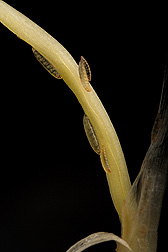This page has been archived and is being provided for reference purposes only. The page is no longer being updated, and therefore, links on the page may be invalid.
Genes Foil Hessian Flies' Feeding on Wheat
By Don ComisApril 5, 2007
Resistant wheat varieties are known to stress Hessian fly (Mayetiola destructor) larvae to death within six days. How this happens is a mystery researchers need to solve to better control the most destructive pest of wheat worldwide.
The recent identification by Agricultural Research Service (ARS) scientists and cooperators of six antioxidant genes in Hessian fly larvae is a step toward solving this mystery. The antioxidants produced by these genes help prevent oxidative damage to the larvae's cell membranes from peroxides, which can be produced both by the wheat plant and by the stresses the larvae suffer.
Rich Shukle, an entomologist in the ARS Crop Production and Pest Control Research Unit at West Lafayette, Ind., and Purdue University entomologists Omprakash Mittapalli and Jonathan Neal identified these genes. They found that the genes produce more antioxidants in larvae trying to feed on resistant wheat plants than in larvae feeding on non-resistant wheat plants. The increase in protective antioxidants is an indicator of stress, and too great a level of stress may kill the larvae.
The stress could be caused by a one-two punch to the larvae. The first blow might be the peroxide poisons that resistant wheat plants emit in their juice, or sap--if larvae are able to extract it. The second blow could be the starvation that results if the larvae fail to extract sap from resistant plants. The only thing for certain is that the masses of larvae failing to feed on resistant wheats soon weaken and die at the base of the plants.
Understanding all the ways that resistant wheat plants stress out Hessian fly larvae should also help scientists better control other insect pests of other crops. This is because peroxides and other toxic oxygen compounds are used by many plants in defending against insects that hunger for them.
A paper on this study was published in February in the journal Proceedings of the National Academy of Sciences.
ARS is the U.S. Department of Agriculture's chief in-house scientific research agency.



